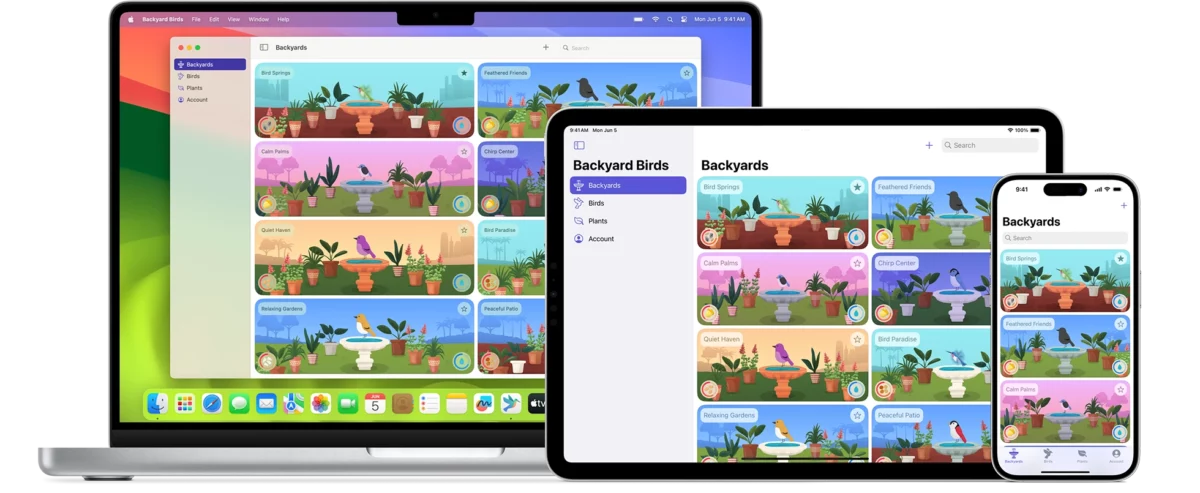Apple has now released the Apple Vision Pro SDK to developers, opening up the flood gates for potential applications for its new spatial computing headset. Here’s everything you need to know…
Apple Vision Pro SDK: Key Takeaways
- Revolutionizing Spatial Computing: Apple’s newly launched Apple Vision Pro SDK is set to revolutionize the world of spatial computing. It provides developers with a robust set of tools to create immersive and interactive 3D experiences.
- Infinite Canvas for Developers: The SDK opens up an infinite spatial canvas for developers to create, experiment, and redefine user-app interactions. It enables seamless transition between traditional views and immersive 3D scenes.
- Core Components: The SDK is built around three key components: Windows, Volumes, and Spaces. These allow developers to create captivating 3D content, add depth to app experiences, and introduce a new concept of app interaction akin to multiple apps on a Mac desktop.
- Expanded SwiftUI for visionOS: Apple has expanded SwiftUI, making it the preferred choice for building apps on the visionOS platform. It offers new 3D capabilities, depth support, intuitive gestures, immersive scene types, and seamless integration with UIKit.
- RealityKit and ARKit: The SDK incorporates RealityKit, Apple’s advanced 3D rendering engine, and ARKit, Apple’s augmented reality framework. These tools enable developers to integrate 3D content, animations, visual effects into their apps, and interact with a user’s physical environment.
- Accessibility Features: visionOS is designed with various accessibility needs in mind, allowing users to interact with their devices using eye gaze, voice commands, or a combination of both.
- Xcode and Reality Composer Pro: Developers can utilize Xcode, Apple’s robust development environment, to create compelling experiences on the visionOS platform. Reality Composer Pro, part of Xcode, simplifies the previewing and preparation of 3D assets for visionOS apps.
- Unity’s Integration with visionOS: Unity, a popular game development engine, has embraced visionOS, allowing developers to create new apps or reimagine existing projects for visionOS.
- The Future of Spatial Computing: With the introduction of the Apple Vision Pro SDK, Apple has positioned itself at the forefront of spatial computing. The SDK empowers developers to create transformative experiences that blur the boundaries between the physical and digital worlds.
Following the launch of the Apple Vision Pro at WWDC 2023, Apple has now begun sharing the Vision Pro’s software development kit (SDK) with developers.
Obviously, because of the nature of Apple’s latest product, it’s a completely new product in a more or less completely new niche, the SDK is pretty complex and covers a lot of different tools and capabilities, so there’s quite a lot of stuff to unpack here.
Here’s everything you need to know about the Apple Vision Pro SDK.
Unleashing the Power of the Apple Vision Pro SDK
Apple Vision Pro SDK is a game-changer, offering developers an infinite canvas to create, experiment, and redefine user-app interactions. The SDK enables the creation of apps that fluidly transition between traditional views and immersive 3D scenes, offering users an unprecedented level of engagement with digital content.
Windows, Volumes, and Spaces
At the heart of Apple Vision Pro are three key components: Windows, Volumes, and Spaces. Developers can use SwiftUI to create windows, integrating traditional views and controls while enhancing the user experience with captivating 3D content.
Volumes: Adding Depth to App Experiences
Volumes, powered by RealityKit or Unity, are SwiftUI scenes that allow developers to display 3D content from any perspective. Whether in Shared Space or an app’s Full Space, users can interact with dynamic environments while staying connected to their surroundings.
Spaces: A New Concept in App Interaction
Spaces, the default launch mode for apps, introduces a concept similar to multiple apps on a Mac desktop. Here, apps coexist, using windows and volumes to present content. For a more immersive experience, developers can create Full Spaces dedicated to displaying an app’s content, allowing for the incorporation of limitless 3D content.
SwiftUI: The Preferred Choice for visionOS

To streamline the development process, Apple has expanded SwiftUI, making it the go-to choice for building apps on the visionOS platform.
SwiftUI offers new 3D capabilities, depth support, intuitive gestures, immersive scene types, and seamless integration with UIKit, enabling developers to adapt their existing iPadOS or iOS apps to the visionOS environment.
- RealityKit: Apple’s Advanced 3D Rendering Engine: RealityKit, Apple’s cutting-edge 3D rendering engine, is a vital part of the Apple Vision Pro SDK. It allows developers to integrate 3D content, animations, and visual effects into their apps, adjusting dynamically to physical lighting conditions and facilitating the creation of stunning visual effects.
- ARKit: Taking Spatial Computing to New Heights: With the integration of ARKit, Apple’s augmented reality framework, Vision Pro elevates spatial computing to unprecedented levels. ARKit enables apps to interact with a user’s physical environment, enhancing apps in the Shared Space with features like Plane Estimation, Scene Reconstruction, Image Anchoring, World Tracking, and Skeletal Hand Tracking.
- Accessibility: A Priority for visionOS: Accessibility is at the forefront of visionOS. Designed with various accessibility needs in mind, visionOS allows users to interact with their devices using eye gaze, voice commands, or a combination of both. Pointer Control provides an alternative navigation method, enabling users to select their index finger, wrist, or head as a pointer.
- Xcode: The Powerhouse for visionOS Development: Developers can utilize Xcode, Apple’s robust development environment, to create compelling experiences on the visionOS platform. Xcode fully supports the visionOS SDK, allowing developers to add a visionOS target to existing projects or build entirely new apps.
- Reality Composer Pro: Simplifying 3D Asset Preparation: For content creation and optimization, Apple offers Reality Composer Pro as part of Xcode. This tool simplifies the previewing and preparation of 3D assets for visionOS apps, integrating tightly with the Xcode build process for efficient previewing and optimization ofvisionOS assets.
- Unity: Embracing visionOS: Unity, a popular game development engine, has also embraced visionOS. Developers familiar with Unity can leverage its authoring tools to create new apps or reimagine existing projects for visionOS. Unity’s integration with RealityKit-managed app rendering ensures that content created using Unity feels native to the visionOS environment.
What is SwiftUI?

SwiftUI represents a significant leap in the world of Apple application development. It’s a framework designed to streamline the app-building process across all Apple platforms, offering a range of powerful features and capabilities. Here’s a simple overview of what SwiftUI brings to the table:
Key Features of SwiftUI
- Universal App Development: With SwiftUI, developers can create apps for all Apple platforms using minimal code. This universality simplifies the development process, making it more efficient.
- Advanced Animation Control: SwiftUI offers sophisticated animation features, including the ability to create complex sequences and multiple animation tracks, enhancing the visual appeal of apps.
- Simplified Data Flow: The use of
@Observablein SwiftUI streamlines data flow, leading to more efficient rendering of user interfaces. - 3D and RealityKit Integration: SwiftUI is adept at building spatial apps, especially for visionOS, incorporating 3D and RealityKit content for immersive experiences.
- Interactive Widgets: Developers can create interactive widgets using SwiftUI, which are adaptable across various Apple devices, enhancing user engagement.
- SwiftData Support: SwiftUI integrates with SwiftData for easy data modeling and efficient data fetching, optimizing app performance.
- Expanded watchOS APIs: SwiftUI has expanded APIs for watchOS, enabling shared code usage and advanced features like adaptive backgrounds and NavigationSplitView.
- Enhanced MapKit APIs: The new MapKit APIs in SwiftUI provide full control over maps, including camera settings, annotations, and various map modes.
- New Chart Types and Interactivity: SwiftUI introduces new chart types, such as pie and donut charts, complete with interactive elements like selection bands.
- Expanded API Coverage: The framework includes new features for scrolling, paging, focus control, and more, broadening its scope of application.
- Declarative Syntax: SwiftUI’s declarative syntax simplifies code, making it more readable and easier to maintain.
- Intuitive Design Tools in Xcode: Xcode provides intuitive tools for building interfaces in SwiftUI, with features like live previews and dynamic code replacement.
- Compatibility with UIKit and AppKit: SwiftUI is designed to work alongside UIKit and AppKit, allowing for its incremental adoption in existing applications.
The Future of Spatial Computing with Apple Vision Pro SDK

With the introduction of the Apple Vision Pro SDK, we will now start to see Vision Pro change and evolve. New applications and uses will emerge as more and more developers get their hands on its SDK.
And this process, as it has been with iPhone, will be an ongoing one. New developers appear every day and bring new applications and ideas with them, so while we are very much at the start of the Vision Pro’s story, things are about to start getting even more interesting.
Check out all the most recent reviews and reactions to Apple’s Vision Pro headset.


